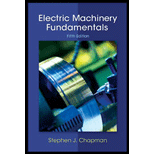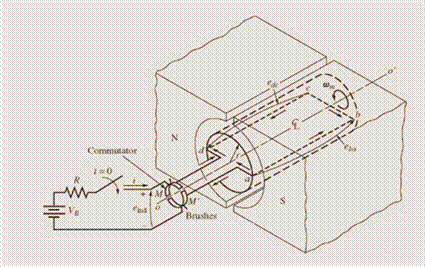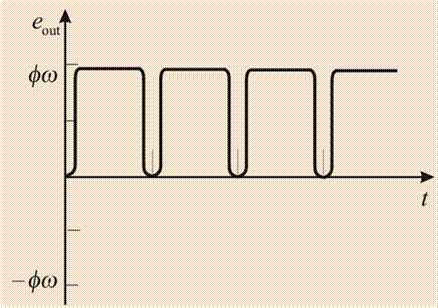
Concept explainers
What is commutation? How can a commutator convert ac voltages on a machine’s armature to dc voltages at its terminals?
To define: The term commutation.
To describe: The process of conversion of ac voltage on the machine’s armature to the dc voltage at the terminals by the commutator.
Explanation of Solution
Commutation is defined as the process of the reversal of the loop connections on the rotor of the DC machine when the polarity is reversed in the loops. The reversal of the loop connection on the rotor if the voltage polarity in the loops reversed is important in order to maintain the output voltage as the pure DC voltage.
The process of the conversion of the AC voltage into the DC by the commutator is described below:

Consider the simple two pole two conductor DC machine as shown above.
Here two conducting segments which are similar added at the end of each conductor. The voltage generated in the machine is collected from the two similar conductors by the help of the two fixed contacts. Here, the fixed contacts are arranged in a way that the conducting segment are shorted at the instant when the voltage induced in the loops is zero.
So, each time the voltage in the loop change their polarity, the conducting segment which are connecting to the fix contacts will change when the conducting segment are revolving with the conductor. The conducting segments are known as the commutator segment. The process of the change of the connection at commutator end is known as the brushes.
The output wave of the DC machine is shown below:

Want to see more full solutions like this?
Chapter 7 Solutions
Electric machinery fundamentals
- Determine the voltage generated by a six-pole dc machine given the following particulars: number of slots in armature = 52; number of conductors per slot = 4; flux per pole = 2.80 x 106 maxwells; speed = 1,200 rpm; number of parallel paths in armature =2. If the armature winding has four parallel paths, what would have been the generated voltage. %3Darrow_forwardSOLVE AND SHOW YPUR COMPLETE SOLUTION. ANSWERS SHOULD BE IN TWO DE CIMAL PLACES. The armature of a two-pole dc machine has 30 slots, each slot has 4 conductors each. during its operation, only 75% of the conductors are directly under the pole. each pole measures 2 inches by 3 inches and produces ten million maxwells of flux. the armature core is 12 inches in length and 3.5 inches in diameter. the total resistance of the winding is 2 ohms. a) determine the frequency of the machine when running at 3600 rpm.arrow_forwardDifferentiate the two types of armature windings in DC machines: lap winding and wave winding.arrow_forward
- SOLVE AND SHOW YOUR COMPLETE SOLUTION. ANSWERS SHOULD BE IN TWO DECIMAL PLACES. The armature of a two-pole dc machine has 30 slots, each slot has 4 conductors each. during its operation, only 75% of the conductors are directly under the pole. each pole measures 2 inches by 3 inches and produces ten million maxwells of flux. the armature core is 12 inches in length and 3.5 inches in diameter. the total resistance of the winding is 2 ohms. e) Determine the total torque exerted by the armature core in ft - lb if the winding is simplex lap winding.arrow_forwardSOLVE AND SHOW YOUR COMPLETE SOLUTION. ANSWERS SHOULD BE IN TWO DECIMAL PLACES. The armature of a two-pole dc machine has 30 slots, each slot has 4 conductors each. during its operation, only 75% of the conductors are directly under the pole. each pole measures 2 inches by 3 inches and produces ten million maxwells of flux. the armature core is 12 inches in length and 3.5 inches in diameter. the total resistance of the winding is 2 ohms. b) determine the total generated voltage if the armature is running at 1000 rpm and its winding is simplex lap connected.arrow_forwardWhat is armature winding? Who discovered it and what is its function?arrow_forward
- SOLVE AND SHOW YOUR COMPLETE SOLUTION. ANSWERS SHOULD BE IN TWO DECIMAL PLACES. The armature of a two-pole dc machine has 30 slots, each slot has 4 conductors each. during its operation, only 75% of the conductors are directly under the pole. each pole measures 2 inches by 3 inches and produces ten million maxwells of flux. the armature core is 12 inches in length and 3.5 inches in diameter. the total resistance of the winding is 2 ohms. c) determine the total generated voltage if the armature is running at 1000 rpm and its winding is simplex wave connected.arrow_forwardSOLVE AND SHOW YOUR COMPLETE SOLUTION. ANSWERS SHOULD BE IN TWO DECIMAL PLACES. The armature of a two-pole dc machine has 30 slots, each slot has 4 conductors each. during its operation, only 75% of the conductors are directly under the pole. each pole measures 2 inches by 3 inches and produces ten million maxwells of flux. the armature core is 12 inches in length and 3.5 inches in diameter. the total resistance of the winding is 2 ohms. d) determine the total force tending to rotate the armature core in lbs, if the winding is simplex lap connected.arrow_forwardExplain distribution of flux and magnetic motive force in AC machines?arrow_forward
 Introductory Circuit Analysis (13th Edition)Electrical EngineeringISBN:9780133923605Author:Robert L. BoylestadPublisher:PEARSON
Introductory Circuit Analysis (13th Edition)Electrical EngineeringISBN:9780133923605Author:Robert L. BoylestadPublisher:PEARSON Delmar's Standard Textbook Of ElectricityElectrical EngineeringISBN:9781337900348Author:Stephen L. HermanPublisher:Cengage Learning
Delmar's Standard Textbook Of ElectricityElectrical EngineeringISBN:9781337900348Author:Stephen L. HermanPublisher:Cengage Learning Programmable Logic ControllersElectrical EngineeringISBN:9780073373843Author:Frank D. PetruzellaPublisher:McGraw-Hill Education
Programmable Logic ControllersElectrical EngineeringISBN:9780073373843Author:Frank D. PetruzellaPublisher:McGraw-Hill Education Fundamentals of Electric CircuitsElectrical EngineeringISBN:9780078028229Author:Charles K Alexander, Matthew SadikuPublisher:McGraw-Hill Education
Fundamentals of Electric CircuitsElectrical EngineeringISBN:9780078028229Author:Charles K Alexander, Matthew SadikuPublisher:McGraw-Hill Education Electric Circuits. (11th Edition)Electrical EngineeringISBN:9780134746968Author:James W. Nilsson, Susan RiedelPublisher:PEARSON
Electric Circuits. (11th Edition)Electrical EngineeringISBN:9780134746968Author:James W. Nilsson, Susan RiedelPublisher:PEARSON Engineering ElectromagneticsElectrical EngineeringISBN:9780078028151Author:Hayt, William H. (william Hart), Jr, BUCK, John A.Publisher:Mcgraw-hill Education,
Engineering ElectromagneticsElectrical EngineeringISBN:9780078028151Author:Hayt, William H. (william Hart), Jr, BUCK, John A.Publisher:Mcgraw-hill Education,





